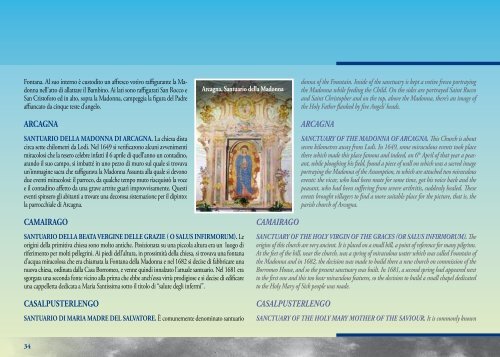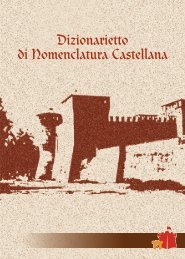luoghi e percorsi tra arte e fede nelle - Provincia di Cremona
luoghi e percorsi tra arte e fede nelle - Provincia di Cremona
luoghi e percorsi tra arte e fede nelle - Provincia di Cremona
You also want an ePaper? Increase the reach of your titles
YUMPU automatically turns print PDFs into web optimized ePapers that Google loves.
Fontana. Al suo interno è custo<strong>di</strong>to un affresco votivo raffigurante la Madonna<br />
nell’atto <strong>di</strong> allattare il Bambino. Ai lati sono raffigurati San Rocco e<br />
San Cristoforo ed in alto, sopra la Madonna, campeggia la figura del Padre<br />
affiancato da cinque teste d’angelo.<br />
arcaGna<br />
santuario della Madonna <strong>di</strong> arcaGna. La chiesa <strong>di</strong>sta<br />
circa sette chilometri da Lo<strong>di</strong>. Nel 1649 si verificarono alcuni avvenimenti<br />
miracolosi che la resero celebre infatti il 6 aprile <strong>di</strong> quell’anno un conta<strong>di</strong>no,<br />
arando il suo campo, si imbatté in uno pezzo <strong>di</strong> muro sul quale si trovava<br />
un’immagine sacra che raffigurava la Madonna Assunta alla quale si devono<br />
due eventi miracolosi: il parroco, da qualche tempo muto riacquistò la voce<br />
e il conta<strong>di</strong>no affetto da una grave artrite guarì improvvisamente. Questi<br />
eventi spinsero gli abitanti a trovare una decorosa sistemazione per il <strong>di</strong>pinto:<br />
la parrocchiale <strong>di</strong> Arcagna.<br />
caMairaGo<br />
santuario della Beata verGine delle Grazie ( o salus inFirMoruM). Le<br />
origini della primitiva chiesa sono molto antiche. Posizionata su una piccola altura era un luogo <strong>di</strong><br />
riferimento per molti pellegrini. Ai pie<strong>di</strong> dell’altura, in prossimità della chiesa, si trovava una fontana<br />
d’acqua miracolosa che era chiamata la Fontana della Madonna e nel 1682 si decise <strong>di</strong> fabbricare una<br />
nuova chiesa, or<strong>di</strong>nata dalla Casa Borromeo, e venne quin<strong>di</strong> innalzato l’attuale santuario. Nel 1681 era<br />
sgorgata una seconda fonte vicino alla prima che ebbe anch’essa virtù pro<strong>di</strong>giose e si decise <strong>di</strong> e<strong>di</strong>ficare<br />
una cappelletta de<strong>di</strong>cata a Maria Santissima sotto il titolo <strong>di</strong> “salute degli infermi”.<br />
casalPusterlenGo<br />
arcagna, santuario della Madonna<br />
santuario <strong>di</strong> Maria Madre del salvatore. È comunemente denominato santuario<br />
CaMairaGo<br />
donna of the Fountain. Inside of the sanctuary is kept a votive fresco por<strong>tra</strong>ying<br />
the Madonna while fee<strong>di</strong>ng the Child. On the sides are por<strong>tra</strong>yed Saint Rocco<br />
and Saint Christopher and on the top, above the Madonna, there’s an image of<br />
the Holy Father flanked by five Angels’ heads.<br />
arCaGna<br />
sanCtuary of the MaDonna of arCaGna. This Church is about<br />
seven kilometres away from Lo<strong>di</strong>. In 1649, some miraculous events took place<br />
there which made this place famous and indeed, on 6 th April of that year a peasant,<br />
while ploughing his field, found a piece of wall on which was a sacred image<br />
por<strong>tra</strong>ying the Madonna of the Assumption, to which are attached two miraculous<br />
events: the vicar, who had been mute for some time, got his voice back and the<br />
peasant, who had been suffering from severe arthritis, suddenly healed. These<br />
events brought villagers to find a more suitable place for the picture, that is, the<br />
parish church of Arcagna.<br />
sanCtuary of the hoLy virGin of the GraCes (or saLus infirMoruM). The<br />
origins of this church are very ancient. It is placed on a small hill, a point of reference for many pilgrims.<br />
At the feet of the hill, near the church, was a spring of miraculous water which was called Fountain of<br />
the Madonna and in 1682, the decision was made to build there a new church on commission of the<br />
Borromeo House, and so the present sanctuary was built. In 1681, a second spring had appeared next<br />
to the first one and this too bear miraculous features, so the decision to build a small chapel de<strong>di</strong>cated<br />
to the Holy Mary of Sick people was made.<br />
CasaLPusterLenGo<br />
sanCtuary of the hoLy Mary Mother of the saviour. It is commonly known<br />
I SANTUARI MARIANI<br />
Marian Shrines<br />
della Madonna dei Cappuccini. Lega le sue origini ad un’antica chiesa de<strong>di</strong>cata a San Salvario, de<strong>di</strong>zione<br />
popolare <strong>di</strong> S. Salvatore, eretta dove oggi sorgono il santuario e il convento. Nel XV secolo la<br />
chiesa venne ornata da una statua in terracotta raffigurante la Madonna col Bambino Gesù e da quel<br />
momento <strong>di</strong>venne un santuario mariano. Nel 1574 vennero chiamati i Cappuccini ad officiare e a<br />
custo<strong>di</strong>re questo luogo sacro e le esigenze devozionali della crescente comunità fecero si che si decise<br />
<strong>di</strong> costruire un convento ed un nuovo santuario consacrato nel 1624.<br />
cavenaGo d’adda<br />
santuario della Madonna e dei ss. rocco<br />
e seBastiano. Il santuario si trova su <strong>di</strong> un’altura denominata<br />
“la costa”. In questa località già esisteva una chiesetta<br />
risalente al XIV secolo resa poi famosa da un fatto miracoloso<br />
risalente al XVII secolo. Nel XIX secolo, con l’aiuto <strong>di</strong> pellegrini<br />
e miracolati, si decise <strong>di</strong> erigere l’attuale santuario che venne<br />
consacrato nel 1878.<br />
34 35<br />
codoGno<br />
santuario Madonna <strong>di</strong> caravaGGio. Il santuario<br />
fu eretto, su progetto <strong>di</strong> Carlo Antonio Albino, sul sito dove già<br />
sorgeva un’e<strong>di</strong>cola de<strong>di</strong>cata alla Vergine apparsa ad una conta<strong>di</strong>na<br />
<strong>di</strong> Caravaggio. La <strong>fede</strong> popolare ed il contributo <strong>di</strong> numerose<br />
elemosine persuasero il Vescovo <strong>di</strong> Lo<strong>di</strong> Ortensio Visconte ad<br />
approvare il progetto <strong>di</strong> una nuova chiesa. L’interno a croce<br />
latina, con un’unica navata, conserva la cripta dove si venera<br />
l’immagine della Madonna. Il Santuario venne consacrato il 1°<br />
maggio del 1946. Il 26 maggio <strong>di</strong> ogni anno si celebra la festa<br />
liturgica della Madonna <strong>di</strong> Caravaggio che vede la presenza <strong>di</strong><br />
numerosi pellegrini.<br />
casalpusterlengo. santuario <strong>di</strong> Maria Madre del salvatore<br />
as the sanctuary of the Madonna of the Capuchins. Its origins are linked to those of another church<br />
de<strong>di</strong>cated to Saint Salvario, a popular name for Saint Salvatore, which was built where nowadays<br />
are found the convent and the sanctuary. During the 15 th century, the church was decorated with a<br />
terracotta statue por<strong>tra</strong>ying the Madonna with Jesus as a child and from that moment on, it became<br />
a Marian sanctuary. In 1574, the Capuchins were called to celebrate services and to take care of this<br />
holy place and the growing requests of the community of believers lead to the buil<strong>di</strong>ng of a convent<br />
and of a new sanctuary which was consecrated in 1624.<br />
CavenaGo D’aDDa<br />
sanCtuary of the MaDonna anD of saint roCCo<br />
anD seBastian. This sanctuary is placed on a hill know as “the<br />
coast”. In this place already existed a small church dating back to<br />
14 th century, which was later made famous by a miraculous event<br />
during 17 th century. In 19 th century, with the help of pilgrims and of<br />
people saved by miracles, the decision to build the present sanctuary<br />
was made and in 1878 it was consecrated.<br />
CoDoGno<br />
sanCtuary of the MaDonna of CaravaGGio.<br />
This sanctuary was built basing on a project by Carlo Antonio<br />
Albino, on a place where was already present an ae<strong>di</strong>cule de<strong>di</strong>cated<br />
to the Virgin Mary who had appeared to a woman from Caravaggio.<br />
Popular belief and a large amount of charity persuaded the<br />
bishop of Lo<strong>di</strong>, Ortensio Visconte, to approve the project of a new<br />
Church. The interior has a Latin cross plant with one aisle only;<br />
here can be found the crypt where the image of the Madonna is<br />
worshipped. The sanctuary was consecrated on 1 st May 1946.<br />
On 26th May every year the liturgical recurrence of the Madon



